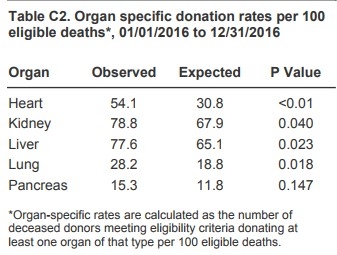Providing Actual Echocardiographic Images to Centers Markedly Increases Transplantation of Deceased Donor Hearts
Organ Procurement, Lifesharing of San Diego, San Diego, CA.
Meeting: 2018 American Transplant Congress
Abstract number: 257
Keywords: Donation, Heart/lung transplantation
Session Information
Session Name: Concurrent Session: Location, Location, Allocation in Heart Transplantation
Session Type: Concurrent Session
Date: Monday, June 4, 2018
Session Time: 2:30pm-4:00pm
 Presentation Time: 3:18pm-3:30pm
Presentation Time: 3:18pm-3:30pm
Location: Room 4C-3
US transplant centers are cautious in accepting deceased donor hearts (DDHs). Even in previously healthy, young brain dead donors, wall motion and other echographic abnormalities are frequently reported by donor hospitals. This contributes to transplant center uncertainty and organ refusal.
In 2016, 47 DDHs that were recovered by our OPO were transplanted, almost a 50% increase in the past 2 years. Our SRTR ratio of observed to expected DDH placement increased in parallel to well above the national average (O:E ratio, figure 1).The O:E ratios are determined from national OPO performance data, adjusted for donor age, cause of death, and other quality measures. This increase in DDH transplantation to well above expectation was spread evenly among multiple donor hospitals and the centers that accepted the organs. Our conversion rate remained unchanged at 75-80%.
What did we do differently? Because specialists may differ in their interpretations of donor echocardiograms, early in 2015 we began using a web-based telecardiology service to make these images available to transplant centers as part of the organ offer, together with an independent expert interpretation. At times this information conflicted with the in-hospital reading. Several centers commented that viewing the images increased their confidence in accepting donor hearts.The increase in O:E placement ratio that occurred in 2015 was accompanied by a trend to a lower mean age for accepted donor hearts (44.6, 40.5, 26.5, and 33.8 respectively from 2013-6), suggesting that hearts from younger donors were accepted with relatively more confidence. Graft survival from 2016 is currently 96%. Use of this strategy to increase center confidence in organ quality could significantly decrease discards of transplantable organs and increase the rate of cardiac transplantation.
Figure 1: Markedly increased ratio of observed to expected (O:E) heart transplants/100 donors in 2016. Starting in 2015, echocardiographic images were made available to heart transplant centers. In 2014 our OPO's O:E ratio was "at expected" for hearts. O:E ratios for other organs were unchanged from 2014 to 2016.
CITATION INFORMATION: Trageser J., Wainaia C., Stocks L., Steiner R. Providing Actual Echocardiographic Images to Centers Markedly Increases Transplantation of Deceased Donor Hearts Am J Transplant. 2017;17 (suppl 3).
To cite this abstract in AMA style:
Trageser J, Wainaia C, Stocks L, Steiner R. Providing Actual Echocardiographic Images to Centers Markedly Increases Transplantation of Deceased Donor Hearts [abstract]. https://atcmeetingabstracts.com/abstract/providing-actual-echocardiographic-images-to-centers-markedly-increases-transplantation-of-deceased-donor-hearts/. Accessed December 25, 2025.« Back to 2018 American Transplant Congress

